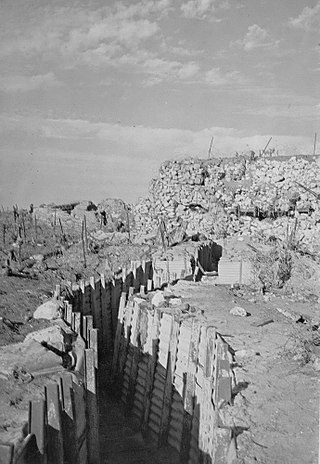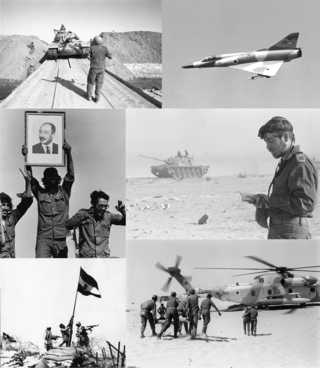
The Yom Kippur War, also known as the Ramadan War, the October War, the 1973 Arab–Israeli War, or the Fourth Arab–Israeli War, was an armed conflict fought from October 6 to 25, 1973 between Israel and a coalition of Arab states led by Egypt and Syria. The majority of combat between the two sides took place in the Sinai Peninsula and the Golan Heights—both of which were occupied by Israel in 1967—with some fighting in African Egypt and northern Israel. Egypt's initial objective in the war was to seize a foothold on the eastern bank of the Suez Canal and subsequently leverage these gains to negotiate the return of the rest of the Israeli-occupied Sinai Peninsula.
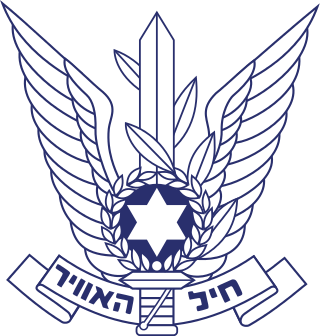
The Israeli Air Force operates as the aerial warfare branch of the Israel Defense Forces. It was founded on May 28, 1948, shortly after the Israeli Declaration of Independence. As of April 2022, Aluf Tomer Bar has been serving as the Air Force commander.

The War of Attrition involved fighting between Israel and Egypt, Jordan, the Palestine Liberation Organisation (PLO) and their allies from 1967 to 1970.
The history of the Israel Defense Forces (IDF) intertwines in its early stages with history of the Haganah.

Operation Badr or Plan Badr was the code name for the Egyptian military operation to cross the Suez Canal and seize the Bar Lev Line of Israeli fortifications on 6 October 1973. Launched in conjunction with a Syrian assault on the Golan Heights, this attack marked the start of the Yom Kippur War.

David "Dado" Elazar was the ninth Chief of Staff of the Israel Defense Forces (IDF), serving in that capacity from 1972 to 1974. He was forced to resign in the aftermath of the Yom Kippur War.
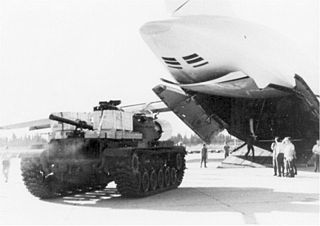
Operation Nickel Grass was a strategic airlift operation conducted by the United States to deliver weapons and supplies to Israel during the 1973 Yom Kippur War. Over 32 days, the United States Air Force (USAF) Military Airlift Command (MAC) shipped 22,325 tons of tanks, artillery, ammunition and supplies in C-141 Starlifter and C-5 Galaxy transport aircraft between 14 October and 14 November 1973. The U.S. support helped ensure that the State of Israel survived a coordinated and surprise attack from the Soviet-backed Arab Republic of Egypt and Syrian Arab Republic.
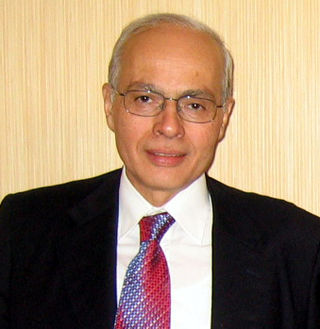
Ashraf Marwan was an Egyptian billionaire who worked as a spy for Israeli Mossad.
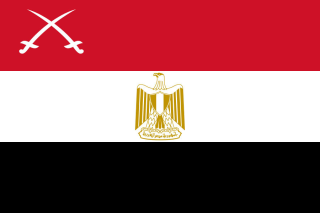
The 2nd Mechanized Infantry Division of the Infantry Corps of the Egyptian Army is a heavy infantry formation created after the Second World War.
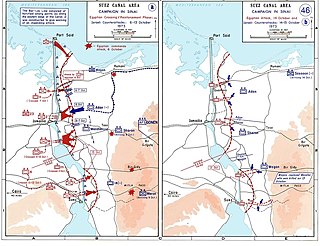
The Battle of the Sinai was one of the most consequential battles of the Yom Kippur war. An Egyptian attacking force that advanced beyond their line of defense at the Bar-Lev Line was repulsed with heavy losses by Israeli forces. This prompted the Israelis to launch Operation Abiray-Lev the next day, penetrating the Egyptian line of defense and crossing the Suez Canal.
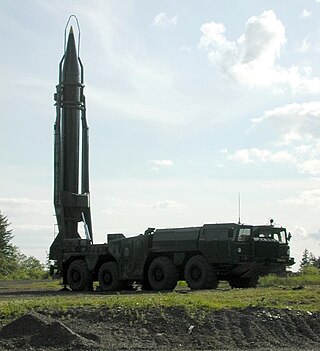
A Scud missile is one of a series of tactical ballistic missiles developed by the Soviet Union during the Cold War. It was exported widely to both Second and Third World countries. The term comes from the NATO reporting name attached to the missile by Western intelligence agencies. The Russian names for the missile are the R-11, and the R-17Elbrus. The name Scud has been widely used to refer to these missiles and the wide variety of derivative variants developed in other countries based on the Soviet design.

The Battle of Ismailia took place between the Egyptian Army and the Israeli Defense Forces (IDF) during the last stages of the Yom Kippur War during October 18–22, 1973, south of the city of Ismailia, on the west bank of the Suez Canal in Egypt. The battle itself took place as part of the larger IDF-launched Operation Abiray-Lev, in an attempt to seize Ismailia and thereby sever the logistical and supply lines of most of Egypt's Second Field Army across the Suez Canal.

The history of Egypt under Anwar Sadat covers the eleven year period of Egyptian history from Anwar Sadat's election as President of Egypt on 15 October 1970, following the death of President Gamal Abdel Nasser, to Sadat's assassination by Islamist fundamentalist army officers on 6 October 1981. Though presenting himself as a Nasserist during his predecessor's lifetime, upon becoming President, Sadat broke with many of the core tenets of the domestic and foreign policy ideology that had defined Egyptian politics since the Egyptian Revolution of 1952. In addition to abandoning many of Nasser's economic and political principles via the Infitah policy, Sadat ended Egypt's strategic partnership with the Soviet Union in favour of a new strategic relationship with the United States, initiated the peace process with the State of Israel in exchange for the evacuation of all Israeli military forces and settlers from Egyptian territory, and instituted a form of politics in Egypt that, whilst far removed from Egypt's pre-revolution democratic system, allowed for some multi-party representation in Egyptian politics. Sadat's tenure also witnessed a rise in governmental corruption, and a widening of the gulf between rich and poor, both of which would become hallmarks of the presidency of his successor, Hosni Mubarak.

Egypt had a history of weapons of mass destruction and used chemical weapons during the North Yemen Civil War. Although it has signed the Nuclear Non-Proliferation Treaty, it still remains one of only four countries not to ratify the Chemical Weapons Convention and has not ratified the Biological Weapons Convention.

This article deals with the history and development of tanks of the Israeli Army, from their first use after World War II in the establishment of the State of Israel after the end of the British Mandate, and into the Cold War and what today is considered the modern era.

Operation Abirey-Halev or Operation Abirey-Lev also known as Operation Stouthearted Men and Operation Valiant, code-named Operation Gazelle, was an Israeli operation that took place in the center of the Suez Canal on 15–23 October 1973 during the Yom Kippur War.

Egypt–North Korea relations refer to bilateral relations between Egypt and North Korea. Egypt has an embassy in Pyongyang whilst North Korea has an embassy in Cairo.





